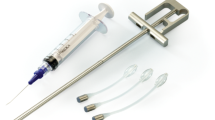Abstract
Introduction
Treatment of recurrent stress incontinence after a failed surgical procedure is more complicated, and repeat surgeries have higher rates of complications and limited efficacy. We determined the technical feasibility, efficacy, adjustability, and safety of adjustable continence therapy device for treatment of moderate to severe recurrent urinary incontinence after failed surgical procedure.
Materials and methods
Female patients with moderate to severe recurrent stress urinary incontinence who had at least one prior surgical procedure for incontinence were enrolled. All patients underwent percutaneous placement of adjustable continence therapy (ACT) device (Uromedica, Plymouth, Minnesota). Baseline and regular follow-up tests to determine subjective and objective improvement were performed.
Results
A total of 89 patients have undergone implantation with 1–3 years of follow-up. Data are available on 77 patients at 1 year. Of the patients, 47% were dry at 1 year and 92% improved after 1-year follow-up. Stamey score improved from 2.25 to 0.94 at 1 year (P < 0.001). IQOL questionnaire scores improved from 33.9 to 71.6 at 1 year (P < 0.001). UDI scores reduced from 60.7 to 33.3 (P < 0.001) at 1 year. IIQ scores reduced from 57.0 to 21.6 (P < 0.001) at 1 year. Diary incontinence episodes per day improved from 8.1 to 3.9 (P < 0.001) at 1 year. Diary pads used per day improved from 4.3 to 1.9 (P < 0.001). Explantation was required in 21.7% of patients.
Conclusion
The ACT device is an effective, simple, safe, and minimally invasive treatment for moderate to severe recurrent female stress urinary incontinence after failed surgical treatment.


Similar content being viewed by others
References
Abrams P, Blaivis JG (1988) Stanton Sl et.al. for the International Continence Committee on Standardization of Terminology: the standardization of terminology of lower tract function. Scand J Urol Nephrol 114(suppl):5–19
Agarwala N, Liu CY (2002) Minimally invasive management of urinary incontinence. Current Opin Obstet Gynecol 14:429–433
Bullock TL, Ghoniem G, Klutke CG et al (2006) Advances in female stress urinary incontinence: mid urethral sling. BJU 98:32–40
Walters MD, Daneshgari F (2004) Surgical management of stress urinary incontinence. Clin Obstet Gynecol 47:93–103
Wilson TS, Lemack GE, Zimmern PE (2003) Management of intrinsic sphincter deficiency in women. J Urol 169:1662–1669
Kuschel S, Schussler B (2008) Results of function and safety of the Safyre-t, a hybrid transobturator vaginal sling for treatment of stress urinary incontinence. Neurourol Urodyn 27:403–406
Amaye-Obu FA, Drutz HP (1999) Surgical management of recurrent stress urinary incontinence: a 12 year experience. Am J Obstet Gynecol 181:1296–1307
Harding CK, Thorpe AC (2008) Surgical treatment for stress urinary incontinence. Int J of Urol 15:27–34
Jarvis GJ (1994) Surgery for genuine stress incontinence. BJOG 101:371–374
de Tayrac R, Deffieux D, Droupy S et al (2004) A prospective randomized trial comparing tension free vaginal tape and transobturator suburethral tape for surgical treatment of stress urinary incontinence. Am J Obstet Gynecol 190:602–608
David-Montefiore E, Frobert JL, Grisard-Anaf M et al (2006) Functional results after suburethral sling procedure for urinary stress incontinence at 1 year: a French prospective multicenter study comparing the retropubic and transobturator routs (abstract). Int Urogynecol J Pelvic Floor Dysfunct 17(suppl 2):S95
Chartier-Kastler E, Costa P, Ben Naoum K et al (2007) French multicenter prospective study of the use of ACT balloons (Uromedica, inc, Plymouth, Min, USA; Medtronic, Minneapolis, USA) for the treatment of female stress urinary incontinence. Prog Urol 17:1372–1377
Kocjancic E, Crivellaro S, Smith JJ et al (2008) Adjustable continence therapy for treatment of recurrent female urinary incontinence. J Endourol 22:1403–1407
Wachter J, Henning A, Roehlich M et al (2008) Adjustable continence therapy for female urinary incontinence: a minimally invasive option for difficult cases. Urol Int 81:160–166
Aboseif SR, Franke EI, Nash SD et al (2009) The adjustable continence therapy system for recurrent female stress urinary incontinence: 1-year results of the North America clinical study group. J Urol 181:2187–2191
Houwert RM, Venema PL, Aquarius AE et al (2009) Predictive value of urodynamics on outcome after midurethral sling surgery for female stress urinary incontinence. Am J of Obstet and Gynecol, www.AJOG.org
Mittenberger M, Pinggera GM, Marksteiner R et al (2008) Adult stem cell therapy for female stress urinary incontinence. Eur Urol 53:169–175
Song PH, Kim YD, Kim HD et al (2009) The 7-year outcome of the tension free vaginal tape procedure for treating female stress urinary incontinence. BJU Int 104(8):1113–1117
Acknowledgments
John F Bressette, Lahey Clinics.
Conflict of interest
The authors declare that they have no conflict of interest.
Author information
Authors and Affiliations
Corresponding author
Rights and permissions
About this article
Cite this article
Aboseif, S.R., Sassani, P., Franke, E.I. et al. Treatment of moderate to severe female stress urinary incontinence with the adjustable continence therapy (ACT) device after failed surgical repair. World J Urol 29, 249–253 (2011). https://doi.org/10.1007/s00345-010-0589-4
Received:
Accepted:
Published:
Issue Date:
DOI: https://doi.org/10.1007/s00345-010-0589-4



